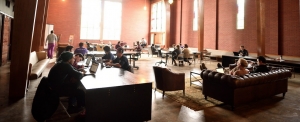Oh My Tech!
The Dreammakers
SimpleCitizen (370 S. 300 East, simplecitizen.com) co-founder and CEO, Sam Stoddard, was at Brigham Young University studying to get his master’s in accounting degree when he met the woman who would become his wife. When they got married, he assumed her immigration process—she’s from South Korea—would be straightforward: he’d fill out some paperwork, she’d be granted citizenship, and that would be it. The experience, however, turned out to be anything but simple.
Stoddard began by enlisting the help of an attorney, who quoted him $3,000 to help secure his wife’s citizenship—obviously cost prohibitive for a student. So, with his background in tax accounting, Stoddard decided he could fill out the forms himself. Nearly four months later, after completing a stack of paperwork rivaling one of the last Harry Potter volumes, he went back to the attorney to make sure his wife’s application was ready for submittal. Five minutes after glancing over the documents, the attorney assured him he’d done the task correctly and handed him a bill for $500.
“Sam knew there had to be a better way,” says SimpleCitizen Vice President of Community, Matthew Gale. So, Stoddard created SimpleCitizen—a digital immigration solution designed to streamline the path to citizenship. He pitched the idea at various BYU tech competitions and others across the state, won some grant money, and eventually built the software. Soon after he partnered with company co-founder, CTO and Mexican immigrant, Aydé Soto, a 2018 Women in Tech Finalist by the Women Technology Council and recipient of the 2018 Sego Award for Innovation in Technology.
From their beginnings in Utah County, the team—which in addition to Stoddard and Soto includes third co-founder and CMO, Brady Stoddard—took their talents and technology to BoomStartup, where they raised money from Kickstart Seed Fund and several other investors, ultimately making the pilgrimage to Silicon Valley for three months in 2016 to join Y Combinator, the startup accelerator of Airbnb, Dropbox and Reddit fame, just to name a few.
Gale describes SimpleCitizen as the TurboTax for immigration. “We started three years ago,” he says, “and since then we’ve helped thousands of immigrants in the United States.” In November 2017, SimpleCitizen launched an enterprise product for companies that employs foreigners to automate their immigration paperwork. Between that, word-of-mouth referrals, and Google reviews, SimpleCitizen is disrupting the immigration process in an incredibly positive way.
Launched in Utah County, SimpleCitizen eventually moved to Salt Lake’s Impact Hub and is now located at Church & State, a non-profit business incubator. “We plan to stay in Salt Lake,” Gale says. “We’re innovating immigration and hope to help as many immigrants as possible. We’re on a mission to help people achieve the American dream.”
The Space Between Giving and Receiving
Within a small Main Street workspace, five earnest 20-somethings sit huddled together, their eyes fixed on the glowing screens in front of them. Their task? Coding and collaborating their way to STEM Mentor Exchange, or STEM MX, a web-based platform which will allow K-12 teachers to provide STEM opportunities to students by connecting them with professionals in the field. And while the scene may not seem that out of the ordinary in tech-friendly downtown Salt Lake, the coders building the platform are a bit unexpected: they are students themselves, earning degrees while getting real-world experience at the Neumont College of Computer Science (143 Main St, neumont.edu). “We’re changing lives through education,” says Neumont President Aaron Reed, Ed.D. from his office on the fourth floor of the school’s campus, the Ezra Thompson Building at 143 South Main Street, colloquially known as the old Tribune building. “We love being downtown,” Reed says. “It’s a major recruiting-plus for us and certainly sweetens the pot for students coming here from all over the country.” 
Approximately 100 students graduate from Neumont every year in degree programs spanning information systems, game development, web design and technology management. As Reed mentioned, more than 80 percent of the student body comes from out of state, and most live in school-sponsored housing downtown, lending their passion to the city’s burgeoning tech scene while getting to take advantage of all that downtown Salt Lake has to offer.
But it’s not only students that Neumont’s staff and faculty hope to impact. “Looking at the numbers, and where things are going on a local, regional and national level, we need more people who code,” Reed says. “The projections at every level show that there are simply not enough computer science or STEM graduates to support the needs of the workplace.”
Which is why students at Neumont get to work on mutually-beneficial projects for businesses and non-profits here and across the country. STEM MX is the result of a collaboration between the college’s Enterprise Partner program and the STEM Partners Foundation, an organization tied to the State of Utah’s STEM Action Center. “When you’re as passionate about computer science education as we are,” Reed says, “you jump on the chance to effect change at every level.”
Solving Problems Yet to Be Realized
“We believe virtual reality is going to disrupt the way we all work, socialize, and entertain ourselves over the next decade in ways that are hard for many people to imagine right now,” says Matt Wilburn, chief operating officer for Daz Productions, Inc. (224 S. 200 West, daz3D.com) a downtown tech firm redefining the tech space through a passion for Virtual Reality (VR) and Augmented Reality (AR).
For the uninitiated, VR immerses users in a fully artificial virtual environment, typically with the use of a VR headset—a technology being used widely in video games and movies. AR, on the other hand, overlays virtual objects onto the real-world environment; an example is the Pokémon Go! craze that swept the world in July 2016. Daz Productions works in both of these realms through two company divisions: Daz 3D and Morph 3D.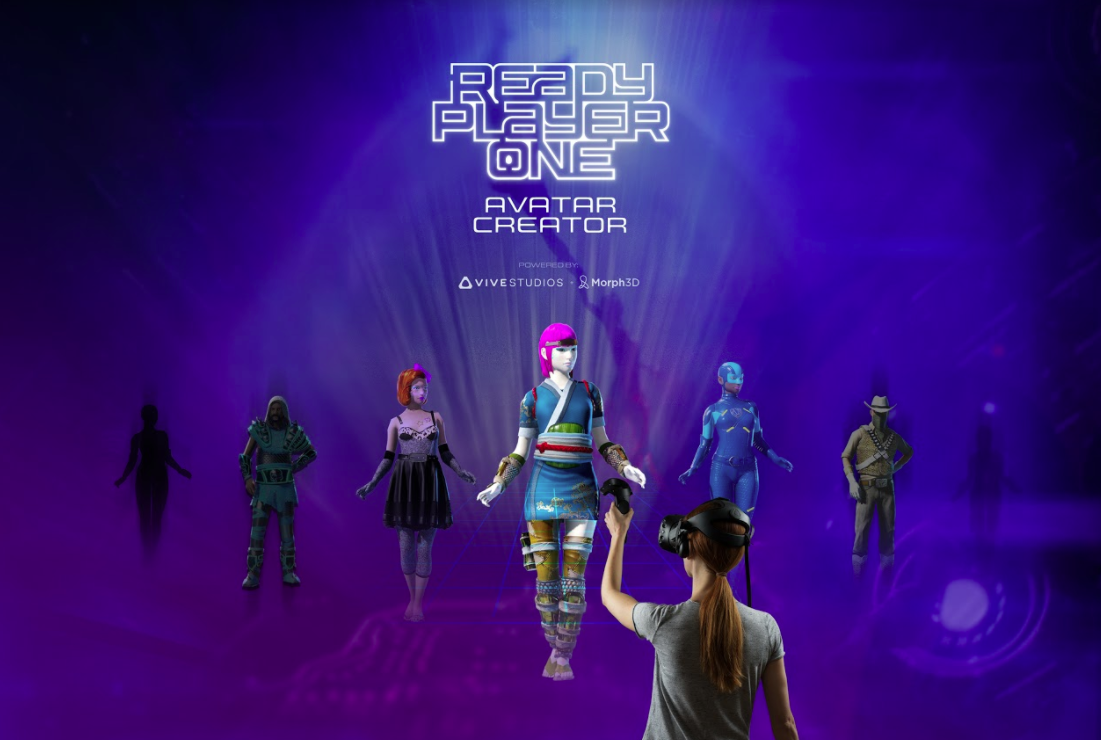
General Manager Berkley Frei explains the work being done at Morph 3D as “solving the problem for everyday people that don’t yet know of the problem that needs to be solved.” Right now, Morph 3D’s state-of-the-art avatar engine is used primarily by developers to create video games, apps, and VR and AR experiences. But as these virtual and augmented worlds expand to the masses, this same avatar engine can be used by consumers. “In our ‘real lives’ we make choices every day about how to present ourselves,” Wilburn says. “It’s no different in virtual worlds: the more you experience VR, the more you’ll want to tailor your appearance and the way you interact with others.” Much like how Blogger and WordPress enabled non-developers to create their own websites, Morph 3D’s avatar engine makes it possible for the average Jane Doe to customize her own avatar for VR.
But, as James Thornton, Daz Productions’ chairman, president and CEO explained, the pathway to getting this technology into the hands of the masses is by forging more business-to-business partnerships; collaborations like Daz Productions, Inc’s recent partnership with Taiwanese consumer electronics company HTC and entertainment giant Warner Bros. to support Steven Spielberg’s blockbuster production of Ernest Cline’s novel, Ready Player One. “We’re providing this technology for multiple platforms, which then gives us access to a much broader audience,” Thornton says.
The Daz 3D side of the business serves professional and recreational artists in more than 200 countries across the globe and has a worldwide customer base totaling tens of thousands.
Daz Productions, Inc. relocated from Draper to downtown Salt Lake City in 2012, a move that Wilburn says has been key in accessing and attracting top creative and software development talent. “We’re waiting for the masses to catch on to the problems we’re solving,” Thornton adds. ”But when they do—and they’re starting to—we’ll access millions of users across the globe, from right here in downtown Salt Lake.”
Coding Back to School
If you aren’t familiar with coding bootcamps, they started cropping up five or six years ago in response to a shortage of software developers relative to the fast-growing tech industry. Since then coding schools have taken off as a lower cost and shorter duration alternative to a four-year degree. And the amazing thing is—they work.
I’m currently attending the Web Development Bootcamp at V School in downtown Salt Lake City. It’s a 12-week, skill-based program where students learn how to build websites and applications. They come out full stack developers, which means that they can code the frontend and backend of a website. The frontend is the look, feel and interactivity of the site; whereas the backend is how data is handled, including servers and databases. It’s wild how much ground can be covered in a 12-week bootcamp when spending every day doing hands-on, applied learning. The wildest thing of all, is that students at V School have a 100 percent job placement rate within six months of graduation. On top of that, many are making the same level of pay as Computer Science graduates from four-year institutions.
Odds are, that last part got your attention. When it comes to getting a job in the tech industry, the people who are hiring are more interested in your skillset than a degree. Above all else, they want to know that you can problem solve and code projects. So, when someone applies to a tech company, it’s common for the company to give the applicant a ‘code challenge.’ A code challenge asks you to solve a problem or build an application. Here’s an example from interviewcake.com: “Write an efficient function that takes stock prices yesterday and returns the best profit I could have made from one purchase and one sale of one Apple stock yesterday.”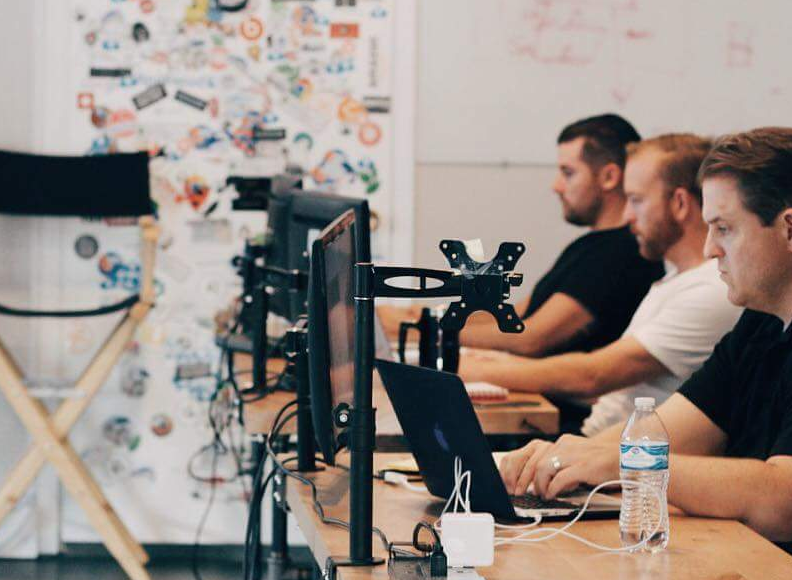
Bottom line, it really is possible to get a software engineering job right out of a bootcamp like this. It’s possible to get one right out of learning in your basement, too—but that’s a lot harder to do. Several V School students spun their wheels trying to learn on their own for years before committing to a bootcamp. The structure of a good bootcamp gets you further and faster with a curriculum that ensures that you know the solid fundamentals needed to write meaningful code that solves problems.
At V School, class runs Monday through Friday from 9 a.m. to 6 p.m. Students can start earlier if they want, working together on problem-solving skills, or even stay late for optional lectures. It’s an immersive environment where you are your only limiting factor. Becoming a software developer in 12 weeks is not a marathon—it’s a sprint. There is no downtime, no filler, no fat. Students should expect to be busy. There is so much to learn every day, and each day builds on the one before. The main difference between learning at a university and learning at a bootcamp comes from learning in an immersive, skill-based environment. There are no long lectures. We don’t write papers. We code. All. Day. Long. At the end of the day, there is no doubt that we are better than we were when the day began.
The early morning instruction and late lectures are available in part because the V School team doesn't have an off switch. The entire staff truly cares about making a difference in students lives. They thrive on seeing students ‘get it.’ It’s been really impressive to find teachers available to answer questions any hour of the day or night, weekday or weekend.
In my class, we have Jacob ‘The’ Evans and Ben Turner teaching. Jacob is eloquent and self-effacing. He has the kind of natural talent for teaching that makes you respect his competence while also being completely entertained. He is at home in front of a class. Ben is the yin to Jacob’s yang. He is soft-spoken and methodical in breaking concepts down. He shines when helping students one on one and has a talent for letting the person he is helping figure out the answer of their question. They both have a true passion and dedication for teaching.
Cohorts at V School are small—there are 12 students in my class. Having a small class size lends itself to quick bonding between students. In my class, we’re constantly joking and razzing each other. It makes it a pleasure to be in class all day, and time passes fast.
Some students at V School are current college students trying to get ahead; some are recent college graduates who don’t want to work in their majors. Others are looking for new careers, and come from a wide variety of backgrounds. Between cohorts we have a physical therapist, an electrician, a graphic designer, an Uber driver, a social media expert, a musician, a shop owner, and a truck driver—just to name a few. The youngest student is 18. The second week of class, he missed a day and we were all wondering where he was. It turned out he was graduating high school. The oldest student in my class is an entrepreneur around 50 years old who wants to manage his developers better. I could go on, but suffice to say V School is a cross-section of what downtown is: dynamic and diverse. As in anything, the people around you have a huge impact on your experience and having such diverse backgrounds creates an amazingly rich environment. We all have our individual strengths, through which everyone helps each other learn.
We’re all here for the same end goal of career building. This isn’t lost on V School. For an hour once a week, there is a class on career skills. Every week it’s a different topic, covering things like resume writing, creating a LinkedIn profile and interviewing skills. Classes also take trips to Q & A with developers at successful, fast-growing companies. It’s an opportunity to learn more about what development jobs are actually like and what skills are valued. I was impressed that the developers we’ve met let us know that the skills we are learning are in high demand and that there are a ton of jobs available in Salt Lake. From downtown to Silicon Slopes, Utah is booming for tech companies, and a skilled workforce is in demand.
The Impact Hub on State Street, where V School is located, is also filled with Salt Lake tech. It’s a work-sharing space that houses a number of startups and emerging tech companies. It’s packed with interesting people, and also runs many events and mixers. The networking opportunities by having the school there are invaluable. Another perk is the central downtown location, with the vibrancy and high energy a suburban campus lacks. At lunch, we usually wander over to the Gallivan Center to sit under the trees in the grass and eat lunch with live music playing nearby. On Thursdays, food trucks line the streets and there’s a band. When I’m leaving school there are often concerts at the Gallivan, and the shows are free many nights. There are also a lot of great restaurants, theaters, bars, art galleries and City Creek Center nearby.
For me, V School has been a great experience, and I would do it again in a heartbeat. The instructors are excellent, my classmates and I are now friends, and I am learning a phenomenal amount. I love being challenged daily. Whether I feel I do well with the day’s challenge or I don’t, I always come out of the day a stronger coder with new skills. Ok, now back to the coding...
Code Lake City
Mo Reeder knows a lot about coding and technology hubs. The University of Utah graduate had worked for and developed several coding schools in San Francisco and Provo Utah before deciding to launch his own coding school, V School, which will open a Salt Lake campus this fall in the Greektown neighborhood in the western edge of downtown Salt Lake.
Reeder worked as the Regional Campus Director at General Assembly, a co-working and global educational company specializing in the skills training technological economy and is one of the largest coding boot camps in the country. Living in the Bay Area taught Reeder a lot about coding, there are about 15 boot camps in the San Fran area.
It is that experience that makes Reeder confident in downtown Salt Lake’s growing tech scene and the role coding schools play in producing skilled tech employees. “Pound for pound the tech scene in Salt Lake is a well kept secret,” said Reeder.
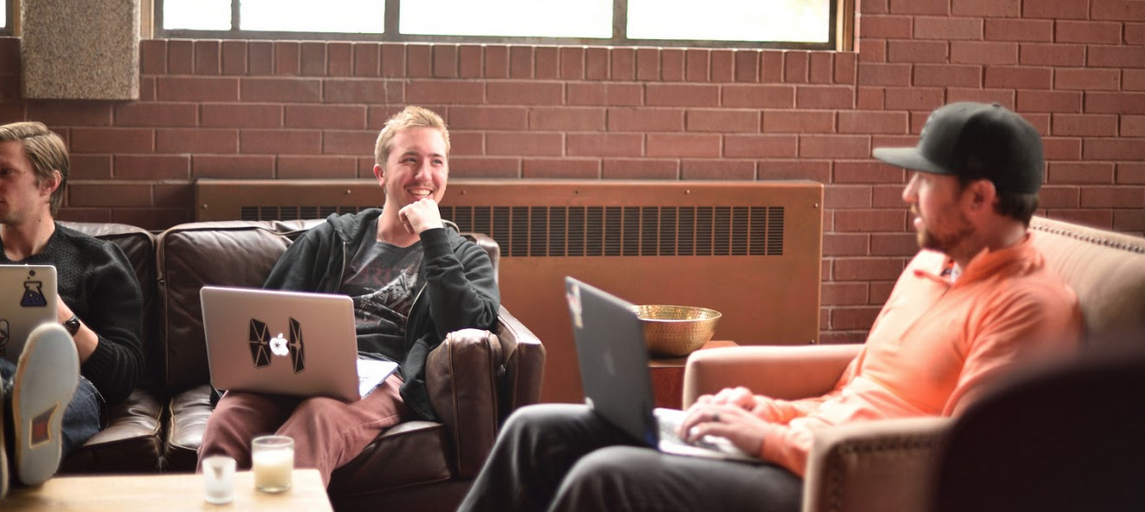
V School is one of four coding schools to move downtown including, DevMountain (a school Reeder helped launch) that like V School began in Provo but has recently added a campus on Main Street between 300 and 400 South. “Salt Lake has an important role in the growing Utah tech scene” said Cahlan Sharp, the co-founder and CEO of DevMountain. “It is the center of what is happening in Utah.”
Utah’s growing tech scene has received an abundance of national press recently. The state is regularly vote the “Best State for Business”, including a July top ranking by CNBC. Forbes Magazine ranked Utah the “Best State for Business and Careers” in 2016 the second consecutive year. The magazine also ranked Utah the second in the country for its list of the “Fastest-Growing States for Tech Jobs in 2015” for Utah’s nearly six percent job growth in the technology sector in 2015.
Companies are drawn to the Wasatch Front, and specifically downtown, for its education workforce and quality of life. With companies like Adobe and Vivint bringing attention to Utah’s Silicon Slopes and Provo becoming an emerging hub for startups, more and more national technology companies will find their way to Utah.
But it is not just the companies relocating here that is attracting national attention. Utah is also building a reputation for quality coding camps. In May, Capella Education Co., a Minneapolis-based company, purchased DevMountain for $20 million. DevMountain started in Provo in 2013 but has expanded to four campuses. Besides its downtown Salt Lake location, the coding camp has locations in Dallas, Texas and Addison, Texas.
Coding camps are different from a standard higher education program. Students learn in small cohorts, with full time coding cohorts usually lasting only 13 weeks. Graduates of coding camps have no trouble finding work. According to Reeder, 100 percent of V School’s graduates found work with the first month after completing the course.
As the technology sector grows, so will the demand for skilled workers. Reeder argued in Salt Lake’s tech sector there is a negative unemployment rate, with an estimated 6,000 unfilled coding jobs in the Salt Lake Valley. The people at coding camp, Iron Yards, saw the potential of Salt Lake’s growing tech economy. The company, which has 22 campuses nationwide, opened up a temporary campus in February in South Jordan. In September the school will begin classes in downtown on Main Street near 300 South.
“Salt Lake has a very strong, robust startup and tech echo system that continues to grow,” said Garrett Clark, the Salt Lake City campus director for Iron Yards. “The business community is doing the right things to attract technology downtown.” Clark cited the growing amount of large companies relocating to downtown Salt Lake as well as the walkability and nightlife as reasons why Iron Yards wanted to be downtown.
The team at Iron Yard estimate that there are 300 jobs open for software engineers every 90 days in the Salt Lake Valley. The challenge for Salt Lake City is to ensure that it is capitalizing on the regional growth economic growth, especially from Utah County. Reeder argues that Salt Lake is the best physically connected city in the region with its public transit access and proximity to the airport. Salt Lake not only has its connectivity to attract companies, but it has the state’s largest and most vibrant downtown.
When Iron Yards and V School start classes this fall, there will be four coding schools operating downtown, along with Neumont University, a for-profit school offering undergraduate degrees in technology.
Neumont moved into the old Tribune building, directly south of the Eccles Theater, bringing hundreds of students downtown. Neumont recently joined forces with Helio Training and will offer coding courses at the university’s downtown campus. Helio joins DevMountain and Iron Yards as coding boot camps operating in the heart of downtown on Main Street."
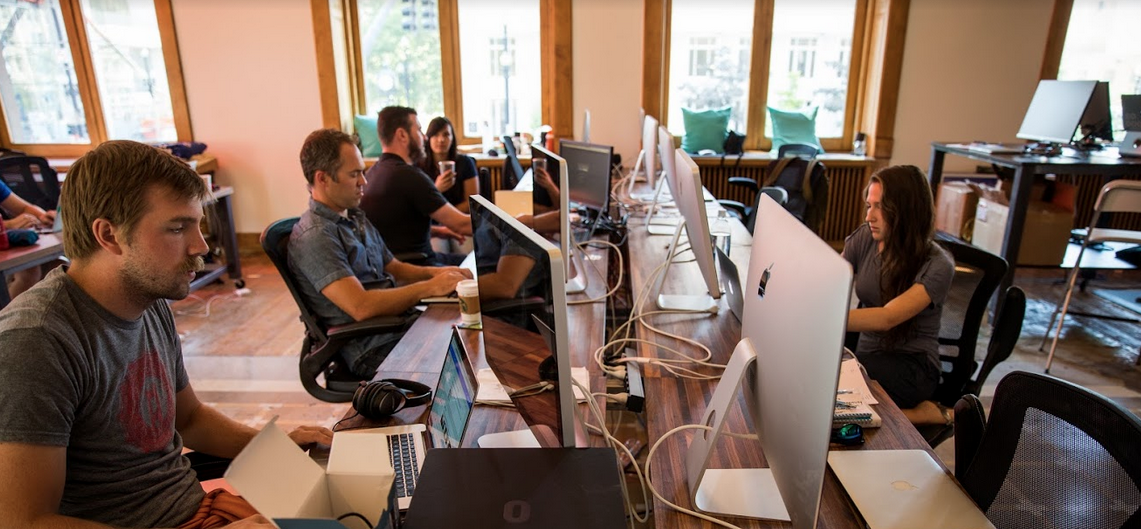
“We love being in downtown Salt Lake, it is not only unique and interesting but it is also really safe,” said Sharp. Sharp argued that Salt Lake’s startup and tech community sets itself apart from Provo and the Silicon Slopes because of its diversity in the variety of startups the city produces. Coding camps are not only providing training for locals, but both schools attract students from out of state. About half of the student body at DevMountain and V School come from out of state.
According to Reeder, most out-of-state students have expressed a desire to stay in the region if they find the right job. While many of the graduates seek employment from established companies, many go the entrepreneurial route and start their own companies. “We are unique because we spit out more companies,” said Reeder. “Twenty-five percent go on to open their companies, meaning every time a student enrolls there is a 25-percent chance that a new company will open in the community and improve economic development.”
Reeder hopes the V Schools location in the Rio Grande District will be a catalyst for growth in the challenged neighborhood. The city, through the Redevelopment Agency of Salt Lake, has created the Station Center project area for the city blocks between the Rio Grande Depot and the Intermodal Transit Hub.
The city plans to turn the area into a vibrant, mixed-use neighborhood that takes advantage of the best public transit access than any other neighborhood along the Wasatch Front. V School’s location on 200 South is directly north of the project area. Reeder expects that many of the school’s students will stay in the area after graduation. As some of the students look to start their own companies, Reeder hopes they’ll consider building their companies in Depot area.
“We aren’t leaving; we will stay on and see the neighborhood get better,” said Reeder.
Neumont University: Tech Success from Salt Lake's Epicenter
It’s an idyllic downtown Saturday morning in early June. Even before the bustle of City Creek traffic has arrived, there’s a buzz of electricity on Main Street. Next door to the almost completed Eccles Theater, the historic Ezra Thompson Building at 143 South Main Street (more commonly known as The Tribune Building) is filled with hundreds of kids and their parents prepping for a day of programming at Neumont University, a private institution that grants bachelor’s degrees in three years in computer science and related fields.
Sponsored by Neumont University, Utah Geek Events and a host of other tech-savvy organizations, Kids Code Con is just one of many ways the institution is helping to support initiatives to make downtown the state’s new technology center with Neumont poised appropriately at the epicenter.

Monday through Friday a different set of tech enthusiasts fill the halls and classrooms of Neumont. Around noon, scores of college students flood into the commons area of campus. They stopped noticing the rumble of TRAX long ago. Inside the university, modern minimalist décor with splashes of contemporary and high-tech style showcase the intersection of the school’s technology focus and the building’s rich history: cement floors, exposed beams and steel cables juxtapose the art-deco exterior and the building’s original elevator lobby. Giant two-story windows are less a line of demarcation between where the building ends and the city begins, but more like Alice’s looking glass –a portal to a different kind of wonderland. In this case, it’s a snapshot of Neumont’s larger campus: the urban playground of downtown Salt Lake.
Amidst the sounds of ping pong and billiard in the school’s main gathering place, students are huddled over laptops or noshing on takeout from local purveyors. The unofficial uniform of the school is a hoodie, jeans and Neumont t-shirt with phrases like, “Eat. Sleep. Code.” or “I know your password” across the chest.
You won’t find a fitness complex, a football team or Greek row at Neumont. Instead, shared interests in technology and gaming are manifested through student groups like League of Legends, Magic the Gathering and activities like coding competitions, gaming tournaments and LAN parties (translation: “local area network,” usually formed for the purpose of engaging in multi-player video games). Needless to say, this is not your typical institution of higher education, and Neumont President Shaun McAlmont says that is entirely by design.

“Our curriculum is built on best practices in the industry,” McAlmont says. “We’ve met with and are continually receiving input from educators and employers from around the country about the needs of the rapidly evolving technology industry and tailor our curriculum to those needs. The result is a computer science education that merges academic rigor, exposure to cutting-edge technologies, and relevant professional knowledge through real-world project-based experience in the workplace before our students have even graduated.”
For students who can handle the pace and demand of the program, it often means not just the start of a career, but landing their dream job right out of college. Enterprise Projects are the key and crown of Neumont’s project-based curriculum. Understandably, Neumont leadership keeps the phrase “internship” out of their vocabulary like, “Voldemort.” But unlike an internship where office lackeys are getting coffee or doing grunt work, Enterprise Projects are contracted work between the university and an employer. For 10 weeks at a time, student teams are given a specific project to use the company’s code and solve real-time issues. It’s a win-win for everyone. The companies get help tackling projects, and Neumont students get actual work experience. Both sides also get a chance to ‘try on one another for size,’ so to speak. Some students are hired to work for an Enterprise Partner before they even graduate.
Willis Towers Watson, an international professional services company with a main office in downtown Salt Lake is a great example of the Enterprise Partner program’s success. The global company has hired more than 30 Neumont graduates in less than 10 years at its Main Street location.
In fact, ninety-seven percent of Neumont graduates are hired in their field within six months of graduation with an average starting salary of $63,000. Yes, that’s the average. Graduates taking positions at big name tech-giants can kick off their careers with compensation packages in the six-figure range.
Class of 2015 alumnus Anthony Corbin of Saginaw, Michigan had lucrative offers from both SONY Santa Monica Studio (i.e. Playstation) and Google before he had even graduated. He accepted Google’s offer before his last day of class and then relocated to California with his wife, Brittany Corbin (neé Waite) a fellow Neumont grad.
Like the Corbins, Neumont graduates are found all over the country in jobs at start-ups to companies like Microsoft, eBay, Amazon, IBM, Nike and Tesla. And even though 82% of Neumont students come from outside of Utah, an impressive portion (more than 50%) stay in Utah to take jobs locally – from previously mentioned Willis Towers Watson to companies like, 1-800 Contacts, IHC, Vivint, Novell and more.
Besides Enterprise Projects, McAlmont says Neumont’s faculty is another key to the school’s blueprint for graduate outcome success.
“Our faculty are specifically chosen for their professional experience and expertise current in the tech industry,” he says. “We’re not asking them to focus on research or publishing. We recruit faculty that are passionate about teaching, about helping students and have real-world experience. Our students are interested in much more than theory. They don’t want to sit and listen to lectures about their field; they want to be creating and solving. They want hands-on participation guided by people who are as passionate as they are, which is why everything at Neumont has a tech slant.”
The methodology works, and has seen so much success that many local companies and individuals have asked when the curriculum will be opened up outside of the traditional student. After years of saying no, a solution came via Helio Training – a sister endeavor, under Neumont University’s parent company - housed just a few buildings down from the school.
Helio’s President Aaron Reed, who has worked with Neumont University for more than 12 years holding positions ranging from teacher and university relations manager to chief operating officer, says Helio’s focus is training primarily in the form of coding “bootcamps” and corporate training – the company has already lead workshops for Willis Towers Watson and eBay.
"We recognize that it isn't possible for everyone to take off three years of work and go to school full time,” Reed said. “We needed to find creative ways to help a different group of people improve their skills. We know what employers are looking for – at Neumont we spent years tailoring our curriculum to fit those needs. So with Helio, non-traditional students get an opportunity to learn software development."
While Helio is one of the latest innovations in Neumont’s arsenal of tech education, there’s even more on the horizon.
"We're an educational institution that prides itself on raising the next generation of the tech elite," McAlmont said. “I’ve seen first hand how education changes lives. It’s the key to success.” And he knows a thing or two about success. In addition to his work and leadership roles at Lincoln Educational Services, Brigham Young University and Stanford University, McAlmont ran track for the Canadian National team and to this day, holds BYU’s sixth-fastest time in the 400-meter hurdles. His résumé includes more than 20 years of experience in the field of education and training.
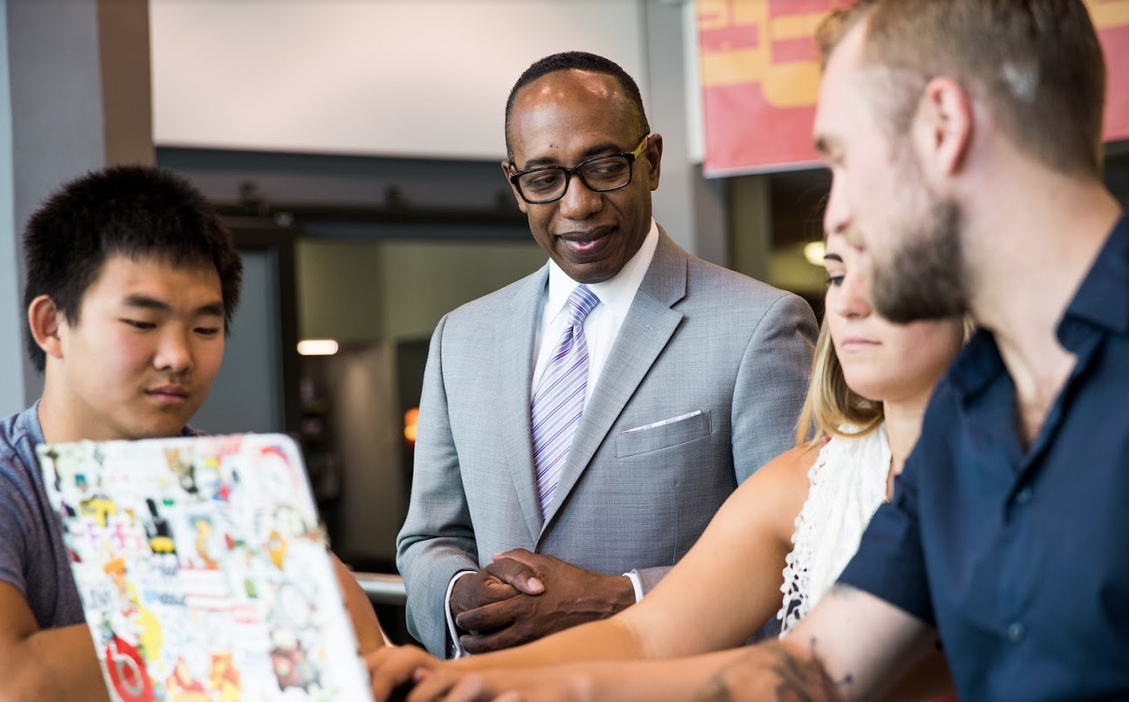
“A passion for coding shouldn't start in college,” McAlmont says. “It's why our students volunteered their time to help elementary students participate in the annual Hour of Code last year and why we offer our building and resources to help host events like Kids Code Con. It's a natural fit for Neumont as we support success in STEM education at every level. Plus it's one more way we can be a force for good in the community.”
While McAlmont took the reigns as Neumont’s president just over a year ago, one of his key initiatives is for the school to be a more vibrant and active member of the community. The result has been even greater participation in events like Salt Lake Comic Con and FanX, Salt Lake Gaming Con, Utah Pride Festival and Eve WinterFest. At his encouragement, staff and students have found other ways to volunteer with quarterly events to help organizations throughout the Salt Lake Valley including the Road Home, Utah Humane Society, and Habitat for Humanity. McAlmont also recently met with Mayor Jackie Biskupski to discuss ways the university can be used to support STEM outreach in the community. Neumont also served as the host site for a meeting of the minds with Downtown Alliance and other tech businesses to talk about more ways to make Salt Lake the tech hub of Utah.
Neumont may not be a household name yet, but with McAlmont at the helm and a student body and force of alumni poised to confront whatever tech challenges are on the horizon (from Pokémon Go to a zombie apocalypse), rest assured this institution will be front and center, leading the charge one keystroke at a time.
Urban Campus
Amid all the business types bustling around Salt Lake’s urban center, a growing population of students are choosing to live in the heart of the city. When they are not studying hard they are playing hard downtown and bringing a young, ambitious vibe to Utah’s urban center.
Florence Hernandez, 19,
Neumont Univerisity
Major: Computer Science.
Florence Hernandez moved to Salt Lake City sight unseen from Forth Worth, TX to pursue her computer science degree at Neumont University’s Main Street Campus. And although, she most likely has no idea who Mary Tyler Moore is, the vivacious 19-year-old certainly had her “Mary Tyler Moment” twirling in the streets of her new city streets last fall. “It was so clean and it was colder than where I’m from,” she says. “It felt so invigorating, like a breath of fresh air. Everything was so bright and roomy, I loved the energy. I really felt like I was starting my life.” Hernandez, who was a standout student back home, always knew she was going to leave Texas and says she chose Neumont because of its tech emphasis and accelerated three-year program. And she loves her school and quickly got involved, becoming Neumont’s first ever female student body president and quickly making friends. “In my first week I just knew everyone was like me, they didn’t know anybody either and I was just so excited and happy I think my enthusiasm helped me make a lot of friends,” she says. “Back home I was an outcasts my interests were so different but here there are lots of people who like the same things I do.” Hernandez lives near 300 South and 600 East and loves walking downtown to school every day explaining that she “grew up in this suburban area where it took a 30-minute drive to get anywhere, I love using my legs.” When she’s not hard hitting the books she’s exploring her new city. “There is always something to do, always a new place to discover, some little crevasse that becomes our new hangout spot,” she says. “It continues to blow my mind.”

Kris Boardman, 36,
University of Utah
Major: Business Communications
Kris Boardman took the long way towards finishing her degree. After high school in Ogden she started at then Weber State but realized she just wasn’t ready or focused enough to pursue school seriously. And that’s how Kris Boardman approaches everything: seriously. So she got a job working for international hotel company Wyndam and saw the world, traveling constantly for work. After spending her 20s in a corporate life on the road, she hung it up and took a year off to play. “I decided I wanted to travel for myself, and try new things,” she says. “I needed that break.” Then she got serious and headed back school with a decade of practical work experience under her belt. “The University of Utah is really good for non-traditional students,” she says. “They don’t expect me to join sorority or do a bunch of activities.” During her previous life she had lived near Trolley Square but traveled so much that she never really got to know the city. So when she opted to resume her studies she deliberately chose to locate herself in the artsy Pierpont Area of downtown. “I am such a city girl,” she says. “I love walkable neighborhoods and I love the buzz. I walk to the farmer’s market, to restaurants and like the sense of community here. I like knowing the restaurant owners and people at the businesses I frequent.” Boardman loves school and says she is glad she took the time to work and gain experience before resuming her studies. When she’s not hard at work on campus she’s on a trail run in Millcreek, getting her namaste on at Centered City Yoga and exploring her city. “Most of my friends live between downtown and Sugar House,” she says. “Everybody bikes to everything and I just love that there is this awareness towards greener healthier lifestyles. I like that that’s the norm here.”

James Goodman, 25
Utah Valley University
Major: Management
James Goodman loves Utah Valley University but he says he wanted to live in downtown Salt Lake. “I grew up in Orem but moved downtown five years ago,” he says. “I just love it and it’s worth it to me to drive or take the train so I can live here.” Goodman lives near the library and says it’s the perfect neighborhood for he and his husband Jeffrey Gomez. “We just love walking over the Les Madelines or stopping into Bar X, we can go to all the festivals and the farmer’s market, and the Gallery Strolls are always nearby,” he says. “ Christmas in SLC, is an especially special time for James and Jeffrey, who celebrate their wedding anniversary walking amid downtown’s Christmas lights. “It’s funny but when we bought our condo we thought we didn’t want to live in Utah forever. But I feel completely differently now. I could spend years here.” Salt Lake’s open vibe suits Jeffrey and James just fine and like many “new urbanists” he says they chose to live an “experienced-based” life. “We’re not paying for a big yard,” he says. “We’re paying for being able to walk around the corner to our favorite store. I don’t want to spend my time mowing a lawn or cleaning a big house. We want experiences.”




